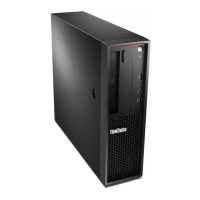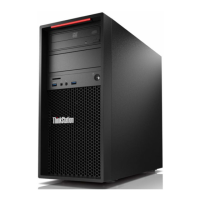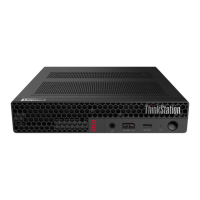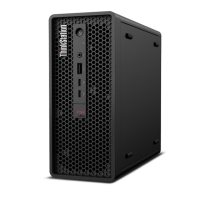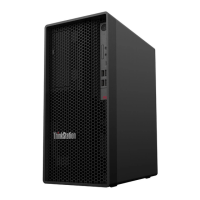
Do you have a question about the Lenovo ThinkStation P310 and is the answer not in the manual?
| Tcase | 71 °C |
|---|---|
| Bus type | DMI3 |
| Stepping | R0 |
| Processor cache | 8 MB |
| Processor cores | 4 |
| System bus rate | 8 GT/s |
| Processor family | Intel® Core™ i7 |
| Processor series | Intel Core i7-6700 Desktop series |
| Processor socket | LGA 1151 (Socket H4) |
| Processor threads | 8 |
| Processor codename | Skylake |
| Processor frequency | 3.4 GHz |
| Processor cache type | Smart Cache |
| Processor lithography | 14 nm |
| Processor manufacturer | Intel |
| Processor front side bus | - MHz |
| PCI Express slots version | 3.0 |
| Processor boost frequency | 4 GHz |
| Processor operating modes | 64-bit |
| ECC supported by processor | No |
| PCI Express configurations | 2x8, 1x8+2x4, 1x16 |
| Thermal Design Power (TDP) | 65 W |
| Number of processors installed | 1 |
| Maximum number of PCI Express lanes | 16 |
| Memory types supported by processor | DDR3L-SDRAM, DDR4-SDRAM |
| Memory voltage supported by processor | 1.35 V |
| Memory clock speeds supported by processor | 1333, 1600, 1866, 2133 MHz |
| Memory bandwidth supported by processor (max) | 34.1 GB/s |
| Maximum internal memory supported by processor | 64 GB |
| Non-ECC | Yes |
| Memory slots | 4x DIMM |
| Internal memory | 16 GB |
| Memory channels | Dual-channel |
| Memory clock speed | 2133 MHz |
| Internal memory type | DDR4-SDRAM |
| Memory layout (slots x size) | 1 x 16 GB |
| SSD capacity | The Solid State Drive's storage capacity in Gigabytes. |
| SSD interface | SATA III |
| Storage media | SSD |
| Optical drive type | DVD±RW |
| Total storage capacity | 256 GB |
| Operating system installed | Windows 7 Professional |
| Cabling technology | 10/100/1000Base-T(X) |
| Ethernet LAN data rates | 10, 100, 1000 Mbit/s |
| USB 2.0 ports quantity | 2 |
| USB 3.2 Gen 1 (3.1 Gen 1) Type-A ports quantity | 6 |
| USB 3.2 Gen 1 (3.1 Gen 1) Type-C ports quantity | 0 |
| Chassis type | Tower |
| Product color | Black |
| Placement supported | Vertical |
| Audio chip | Realtek ALC662 |
| Product type | Workstation |
| Motherboard chipset | Intel® C236 |
| Sustainability certificates | RoHS, EPEAT Gold, ENERGY STAR |
| On-board graphics card ID | 1912 |
| Discrete graphics card model | NVIDIA® Quadro® M2000 |
| On-board graphics card model | Intel® HD Graphics 530 |
| Discrete graphics card memory | 4 GB |
| Maximum on-board graphics card memory | 1.74 GB |
| On-board graphics card OpenGL version | 4.4 |
| On-board graphics card base frequency | 350 MHz |
| On-board graphics card DirectX version | 12.0 |
| On-board graphics card dynamic frequency (max) | 1150 MHz |
| Number of displays supported (on-board graphics) | 3 |
| Power supply | 250 W |
| Scalability | 1S |
| Processor code | SR2BT |
| Processor ARK ID | 88196 |
| Processor package size | 37.5 x 37.5 mm |
| Supported instruction sets | SSE4.1, AVX 2.0, SSE4.2 |
| Thermal solution specification | PCG 2015C |
| Intel Secure Key Technology version | 1.00 |
| Depth | 426 mm |
|---|---|
| Width | 175 mm |
| Height | 376 mm |
| Weight | 13000 g |
Describes the physical layout of computer hardware components on the front and rear views.
Details the internal parts of the computer, such as heat sinks, fans, and drives.
Illustrates and lists components located on the motherboard.
Explains the function and location of internal storage devices like HDDs and SSDs.
Identifies the computer's machine type and model number for service and support.
Lists and describes the computer's various hardware and software features, including I/O and expansion.
Provides physical dimensions, weight, environmental operating conditions, and electrical input.
Information on accessing and using preinstalled Lenovo programs on the operating system.
Guide on how to register your computer with Lenovo for support and service.
Steps to adjust the computer's audio volume using the Windows notification area.
Instructions for using optical drives and handling discs, including guidelines for optical drives.
Steps for establishing wired (Ethernet) and wireless network connections.
Guidelines for ergonomic setup, glare reduction, and proper air circulation.
Features and shortcuts for users with disabilities, including keyboard shortcuts and Ease of Access.
Procedures and precautions for safely cleaning computer surfaces and components.
Basic tips and good practices for keeping the computer functioning properly and in good condition.
Precautions for safely moving the computer, including international considerations and packing.
Methods to secure the computer case using padlocks and Kensington-style cable locks.
How to access and modify security options, such as passwords, in the BIOS setup utility.
Guidance on using BIOS and Windows accounts to prevent unauthorized access to data.
Information on the preinstalled antivirus software for guarding against, detecting, and eliminating viruses.
Overview of accessing and changing computer configuration settings in the BIOS.
Steps to enable or disable hardware devices, like USB ports, via the Setup Utility.
How to adjust BIOS settings, such as OS optimized defaults, for OS installation.
Details on setting, changing, and deleting power-on, administrator, and hard disk passwords.
How to change the boot order permanently or select a temporary startup device.
Instructions for configuring Redundant Array of Independent Disks (RAID) levels.
Procedures for updating the BIOS and recovering from a BIOS update failure.
A systematic approach to diagnosing and fixing computer issues, including checks and recovery.
Solutions for common problems like startup, audio, CD/DVD, storage, and network issues.
How to use diagnostic programs, like Lenovo Solution Center, to test hardware components.
Steps for recovering the operating system using Windows solutions or Lenovo recovery tools.
Precautions to prevent damage from static electricity during hardware handling and installation.
General instructions for expanding or maintaining computer capabilities by installing or replacing parts.
Connecting peripherals like external speakers, printers, or scanners to the computer.
Step-by-step guide to safely remove the computer's outer casing for internal access.
Instructions for installing or replacing PCI Express expansion cards.
Procedures for installing or replacing M.2 solid-state drives.
Guide for installing or replacing DDR4 UDIMM RAM modules.
Steps to install or replace CD/DVD drives in the computer or flex modules.
Instructions for installing or replacing HDDs in the front-access storage enclosure.
Steps to safely replace the computer's internal CMOS battery.
Guide for replacing the computer's internal power supply unit.
Instructions for replacing the CPU heat sink and fan assembly.
Procedures for installing or replacing SSDs into various drive bays or converters.
Guide for replacing the main internal hard disk drive.
Instructions for replacing a secondary internal hard disk drive or SSD.
Steps to replace the computer's front cooling fan assembly.
Guide for replacing the computer's rear cooling fan assembly.
Instructions for replacing Wi-Fi adapter card, module, and antenna.
Final steps after installing or replacing hardware, including reassembly and configuration.
Accessing user guides, Windows help, safety information, and Lenovo websites.
Overview of the Lenovo Support website for drivers, diagnostics, and product details.
Information on obtaining support via telephone and available warranty services.
Details on compatible memory modules (UDIMM) and their frequencies for ThinkStation models.
FCC compliance statements for radio frequency emissions, including Class B limits.
EU compliance requirements for electromagnetic compatibility of electronic equipment.
Guidelines for the responsible disposal and recycling of electronic waste (WEEE).
Procedures for collecting and recycling disused Lenovo computers and monitors in Japan.
Compliance with EU directive restricting the use of certain hazardous substances in electronics.
Compliance with China's regulations on the restriction of hazardous substances in electronic products.
Details on power-saving features configured for ENERGY STAR compliance.
Lists registered trademarks of Lenovo, Microsoft, Intel, and other companies.

